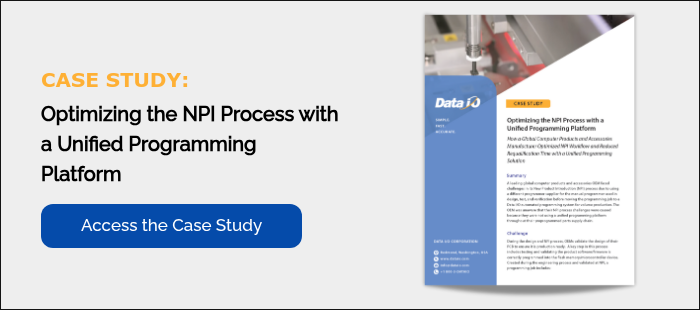For OEMs, the New Product Introduction (NPI) process is critical in ensuring that new designs are ready for production. A key step in this process is programming the flash memory or microcontroller devices to validate that the firmware or software is correctly written. However, inconsistencies can arise when different programming platforms are used during design, NPI, and production, leading to increased costs, delays, and quality issues.
A global manufacturer of computer products and accessories faced these exact challenges. Their NPI workflow relied on a different programming supplier for design, test, and validation before transitioning to a Data I/O automated programming system for volume production. This mismatch in platforms led to inefficiencies, requiring additional requalification time and increasing the risk of programming errors.
Download the full case study to see how this OEM overcame these challenges with a unified programming platform.
The Risks of Using Different Programming Platforms
Using different programming solutions during NPI and production creates several challenges:
- Inconsistent Programming Results – Proprietary algorithms from different vendors can lead to mismatched checksums and failed verifications.
- Increased Human Error – Recreating programming jobs from scratch for production increases the chance of mistakes.
- Higher Costs – Different programming platforms require separate adapters, adding unnecessary expense.
- Delays in Production – Algorithm requalification slows down the transition from NPI to volume manufacturing.
For manufacturers striving for efficiency, these challenges can disrupt timelines, add costs, and impact overall product quality.
A Unified Solution for Seamless NPI to Production
To address these inefficiencies, the OEM implemented Data I/O’s FlashCORE manual programmer for NPI, aligning it with their existing PSV3500 automated programming system used in volume production. This shift to a unified programming platform allowed them to:
- Seamlessly transfer validated programming jobs from engineering to production.
- Eliminate algorithm requalification between different programming suppliers.
- Use shared socket adapters across design, NPI, and production phases.
By integrating a single programming platform from the start, the OEM optimized their NPI workflow and removed barriers to efficient production.
Measurable Results: Improved Efficiency and Quality
By adopting a unified programming platform, the OEM achieved:
- Increased Efficiency – Reduced requalification and failure analysis time.
- Improved Quality – Consistent programming results from engineering through production.
- Supply Chain Optimization – Standardized programming across the entire product lifecycle.
This transformation enabled the manufacturer to accelerate their NPI process, reduce production delays, and improve overall manufacturing reliability.
Download the Full Case Study
Ready to streamline your NPI process and boost manufacturing efficiency?
Download the full case study to discover how a unified programming platform transformed a global OEM’s operations and how it can drive similar results for your business.

